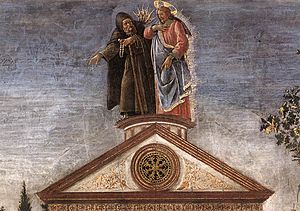- Matthew 4:7
-
 Part of Sandro Botticelli's The Temptation of Christ
Part of Sandro Botticelli's The Temptation of Christ
Matthew 4:7 is the seventh verse of the fourth chapter of the Gospel of Matthew in the New Testament. Satan has transported Jesus to the pinnacle of the Temple of Jerusalem and told Jesus that he should throw himself down as God in Psalm 91 promised that no harm would befall him. In this verse Jesus quotes scripture to rebuff the devil.
In the King James Version of the Bible the text reads:
- Jesus said unto him, It is written again,
- Thou shalt not tempt the Lord thy God.
The World English Bible translates the passage as:
- Jesus said to him, "Again, it is written,
- ‘You shall not test the Lord, your God.’"
For a collection of other versions see BibRef Matthew 4:7
As in his response to the first temptation in Matthew 4:4 Jesus again responds by quoting scripture. This quotation comes from Deuteronomy 6:16 a verse that comes two chapters before that quoted in 4:4. As with the earlier quotation it uses the exact translation found in the Septuagint. In this section of Deuteronomy Moses is instructing the Israelites on proper behaviour. In full Deut 6:16 reads "Do not test the Lord your God as you did at Massah." This is a reference to the events of Exodus 17:5 where the Israelites wandering in the desert doubted God was with them. This passage is thus seen as the clearest evidence for the theory that the temptation narrative shows how Jesus avoided making the same errors as the Israelites. The quoting of Moses' dictate is also seen as a rejection of Antinomianism. Satan had originalyl quoted from Psalms, but Fortna notes that Jesus replies with a more fundamental verse by quotting from the Torah.[1]
In the Gospel of Luke this temptation is the final one, and that is the ordering most commonly used by Christians. By tradition after Jesus rebuffs Satan it is Satan who plummets from the top of the temple, something frequently depicted in art and recounted in some detail in Paradise Regained.
A Muslim tale from the ninth century has a very different ending to this section. In it Jesus refuses to leap because he doubts whether he will be saved.
References
- ^ Fortna, Robert. The Gospel of Matthew - Scholars Bible Polebridge Press, 2005 pg. 49
- Albright, W.F. and C.S. Mann. "Matthew." The Anchor Bible Series. New York: Doubleday & Company, 1971.
- Clarke, Howard W. The Gospel of Matthew and its Readers: A Historical Introduction to the First Gospel. Bloomington: Indiana University Press, 2003.
- Hill, David. The Gospel of Matthew. Grand Rapids: Eerdmans, 1981
Gospel of Matthew Preceded by:
Matthew 4:6Chapter 4 Followed by:
Matthew 4:8Categories:- Gospel of Matthew verses
- Satan
Wikimedia Foundation. 2010.
